Biology MCQs with answers for NEET Menstrual Cycle
Question 1. The cyclic discharge of blood and cellular debris from the uterus through vagina is called
- Estrous cycle
- Reproductive cycle
- Menstrual cycle
- Life cycle
Answer: 3. Menstrual cycle
The menstrual cycle is the regular natural change that occurs in the female reproductive system. It involves the cyclic discharge of blood and cellular debris from uterus, via vagina.
Question 2. The reproductive cycle in the female primate monkeys, apes and human beings is called
- Menstrual cycle
- Menarche
- Menopause
- Ovulation
Answer: 1. Menstrual cycle
“human reproduction mcqs class 12 “
The rhythmic series of changes that occurs in the reproductive organs of female primates (monkeys, apes and human beings) is called menstrual cycle.
Read And Learn More: NEET Biology Multiple Choice Question And Answers
Question 3. Given below are various terms and their related informations.
- Precocious puberty – Puberty attained before normal age.
- Testes – Also called spermaries.
- Luteal phase – Occurs immediate after menstrual phase.
- Anestrus phase – Female mate with male
Choose the option containing incorrectly matched pairs.
- 1 and 2
- 3 and 4
- 2 and 4
- 2, 3 and 4
Answer: 2. 3 and 4
Pairs 3 and 4 are incorrectly matched and can be corrected as Luteal phase occurs immediately after ovulatory phase. During anestrus phase of estrous cycle, female does not mate with male. Rest pairs are correct.
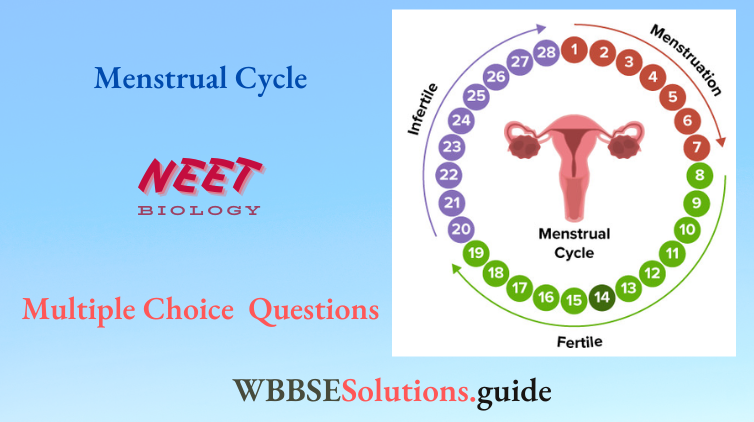
“which hormone control menstrual cycle “
Question 4. Match the items given in Column I with those in Column 2 and select the correct option given below.
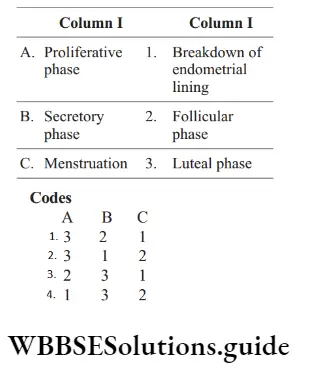
Answer: 3. A-2, B-3, C-1
Question 5. Hormones for the menstrual cycle are produced by
- Ovaries only
- Uterus only
- Ovaries and uterus
- Ovaries and anterior pituitary
Answer: 4. Ovaries and anterior pituitary
Menstrual cycle is regulated by certain hormones, some of which are secreted by the pituitary gland. The hormones produced by the pituitary gland influence the ovaries. The hormones secreted by the ovaries affect the walls of the uterus.
Biology MCQs with answers for NEET
Question 6. The human female shows menstruation at regular intervals right from
- Infancy to puberty
- Puberty to pregnancy
- Menopause to puberty
- Puberty to menopause
Answer: 4. Puberty to menopause
Menstruation usually starts during puberty, between the age of 10 and 16 years and it continue until menopause.
“which hormone controls menstrual cycle “
Question 7. The first menstrual cycle in female is known as
- Menopause
- Menarch
- Reproductive cycle
- Menstruation
Answer: 2. Menarch
Menarch is the technical term for the first menstrual cycle in female.
NEET Biology Menstrual Cycle MCQs with answers
Question 8. Human female is
- Seasonal ovulator
- Occasional ovulator
- Periodical ovulator
- Spontaneous ovulator
Answer: 3. Periodical ovulator
Human female is periodical ovulator, i.e. they ovulates regularly after a certain fixed period.
Question 9. Sequence of hormones during menstrual cycle is Odisha
- Oestrogen, progesterone and FSH
- Progesterone, oestrogen and FSH
- FSH, oestrogen and progesterone
- FSH, progesterone and oestrogen
Answer: 3. FSH, oestrogen and progesterone
The correct sequence of hormonal regulation during menstrual cycle is FSH (stimulation of Graafian follicles), oestrogen (endometrium thickening), LH (ovulation), progesterone (maintenance of pregnancy).
Question 10. Menstrual cycle starts when there is
- Decrease in progesterone level
- Increase in oestrogen level
- FSH release
- Release of oxytocin
Answer: 1. Decrease in progesterone level
Menstrual cycle starts with bleeding phase or menstruation. Decrease in progesterone level leads to shedding of uterus lining during this phase.
Biology MCQs with answers for NEET
Question 11. Changes in GnRH pulse frequency in females is controlled by circulating levels of
- Progesterone only
- Progesterone and inhibin
- Oestrogen and progesterone
- Oestrogen and inhibin
Answer: 3. Oestrogen and progesterone
- GnRH is secreted by the hypothalamus which stimulates the anterior lobe of pituitary gland to secrete Luteinizing Hormone (LH) and FSH. FSH stimulates the growth of the ovarian follicles and stimulates the formation of oestrogens.
- LH stimulates the corpus luteum to secrete progesterone. Rising levels of progesterone and oestrogen inhibits the release of GnRH, which in turn, inhibits the secretion of FSH and LH.
Question 12. The area that experiences the greatest change during menstrual cycle is
- Vagina
- Perimetrium
- Cervix
- Endometrium
Answer: 4. Endometrium
Endometrium wall of uterus periodically changes in different stages of menstrual cycle.
Important MCQs on Menstrual Cycle for NEET
Question 13. Some important events in the human female reproductive cycle are given below. Arrange the events in a proper sequence.
- Secretion of FSH
- Growth of corpus luteum
- Growth of the follicle and oogenesis
- Ovulation
- Sudden increase in the levels of LH
Choose the correct answer
- I → 4 → 3 → V → 2
- 2 → I → 3 → 4 → V
- 3 → I → 4 → 2 → V
- I → 3 → V → 4 → 2
Answer: 4. I→3→V→4→2
Question 14. Which one of the following statements is/are correct?
- FSH and LH occur in both males and females
- FSH and LH stimulate the follicle to secrete oestrogen
- The ovarian cycle depends on the blood levels of FSH and LH
- All of the above
Answer: 4. All of the above
All the given statements are correct.
Question 15. Which one of the following is the most likely the root cause for menstruation is not occurring in human female regularly?
- Maintenance of the hypertrophical endometrial lining
- Maintenance of high concentration of sex hormones in the blood stream
- Retention of well-developed corpus luteum
- Fertilisation of the ovum
Answer: 2. Maintenance of high concentration of sex hormones in the blood stream
- High concentration of sex steroids (oestrogen) exerts negat4e feedback on anterior pituitary, thus decreasing the LH and FSH secretion and their release.
- It lowers the level of LH and FSH in blood. Due to insufficient LH level, ovulation does not occurs which causes irregular menstruation.
Question 16. Assertion Level of gonadotropins in blood increases during puberty. Reason (R) Increased level of LH and FSH are responsible for initiating menstrual cycle.
- Both A and R are true and R is the correct explanation of A
- Both A and R are true, but R is not the correct explanation of A
- A is true, but R is false
- Both A and R are false
Answer: 1. Both A and R are true and R is the correct explanation of A.
Increased level of gonadotropins, LH and FSH is observed during puberty due to the secretion of GnRH from hypothalamus. These hormonal changes induce the onset of menstrual cycle.
Question 17. Which one of the following statements is incorrect about menstruation ?
- At menopause, there is abrupt increase in gonadotropic hormones
- The beginning of menstruation cycle is called menarche
- During normal menstruation, about 40 mL blood is lost
- The menstrual blood can clot easily
Answer: 4. The menstrual blood can clot easily
Statement in option 4 is incorrect and can be corrected as Menstrual blood do not clot due to the presence of fibrinolysin in it. Other statements are correct.
Biology MCQs with answers for NEET
Question 18. Assertion After ovarieotomy, menstrual cycle in woman may be stopped. Reason (R) Ovarian hormones induce menstrual cycle.
- Both A and R are true and R is the correct explanation of A
- Both A and R are true, but R is not the correct explanation of A
- A is true, but R false
- Both A and R are false
Answer: 1. Both A and R are true and R is the correct explanation of A.
Ovaries secrete steroid sex hormones like progesterone and oestrogen which are responsible for controlling menstrual cycle. Ovarieotomy or removal of ovary would stop menstrual cycle permanently.
Question 19. Menstrual phase is known as
- luteal phase
- Destructive phase
- Follicular phase
- Ovulatory phase
Answer: 2. Destructive phase
Menstrual phase is known as destructive phase because it involves the destruction of uterine walls.
“biology human reproduction “
Question 20. The number of days for which the menstrual phase of menstrual cycle lasts is about
- 28
- 14
- 10
- 4
Answer: 4. 4
Menstruation is the stage of the menstrual cycle during which the endometrium is shed because fertilisation has not occurred. It occurs for about 4 days.
Question 21. Assertion During menstrual phase about 50-100 mL of blood is lost. Reason (R) In the menstrual phase, shedding of endometrial lining along with ovum takes place due to reduced titre of oestrogen and progesterone.
- Both A and R are true and R is the correct explanation of A
- Both A and R are true, but R is not correct explanation of A
- A is true, but R is false
- Both A and R are false
Answer: 2. Both A and R are true, but R is not the correct explanation of A.
Menstrual phase continues for 3- 5 days and involves the discharge of blood (a total of 50-100 mL) along with casting off endometrial lining. It occurs due to reduced concentration of oestrogen and progesterone
Menstrual Cycle chapter-wise MCQs for NEET
Question 22. Menstruation is caused due to
- Breakdown of the endometrium
- Rupture of the Graafian follicle
- Releasing of progesterone
- None of the above
Answer: 1. Breakdown of the endometrium
Breakdown of uterine endometrium in the absence of fertilisation and decreased level of progesterone causes menstruation.
Question 23. Menstrual flow occurs due to the lack of
- Progesterone
- FSH
- Oxytocin
- Vasopressin
Answer: 1. Progesterone
Menstruation occurs when the progesterone secreting structure, i.e. corpus luteum disintegrate in the absence of fertilisation. Thus, the level of progesterone decreases in blood during menstruation.
Biology MCQ For NEET With Answers
Question 24. Levels of oestrogen and progesterone are minimum at the time of
- Onset of menstrual phase
- Secretory phase
- Ovulation
- Follicular phase
Answer: 1. Onset of menstrual phase
Menstruation occurs when the progesterone secreting structure, i.e. corpus luteum disintegrate in the absence of fertilisation. Thus, the level of progesterone decreases in blood during menstruation.
Question 25. Dysmenorrhoea means
- Absence of menstruation
- Painful menstruation
- Heavy bleeding
- Irregular menstruation
Answer: 2. Painful menstruation
Dysmenorrhoea means painful menstruation or menstrual cramps. The pain usually occur in the pelvis or lower abdomen.
Question 26. Menstruation indicates the
- Confirmation of pregnancy
- Absence of pregnancy
- Suppression of pregnancy
- Maturity
Answer: 2. Absence of pregnancy
Menstruation indicates the absence of pregnancy as it occurs when secondary oocyte is not fertilised.
Question 27. Identify the event that occurs at the beginning of menstruation.
- Ovulation takes place
- Corpus luteum degenerates
- Progesterone and oestrogen level increases
- Levels of LH and FSH increases
Answer: 2. Corpus luteum degenerates
In beginning of menstrual phase, the corpus luteum degenerates because of decreasing progesterone level in the absence of fertilisation. This leads to the degradation of endometrium wall.
Biology MCQ For NEET With Answers
Question 28. Low levels of LH during the secretory phase of the menstrual cycle are primarily due to
- Low oestrogen level
- Inhibin
- Low progesterone level
- High oestrogen and progesterone level
Answer: 4. High oestrogen and progesterone level
At the onset of secretory or luteal phase, level of gonadotropin like LH decreases due to increased secretion of progesterone. A secondary rise in oestrogens causes further gonadotropin suppression.
Question 29. The phase of menstrual cycle in humans in which repair of endometrium takes place is called
- Menstrual phase
- Proliferative phase
- Secretory phase
- Ovulatory phase
Answer: 2. Proliferative phase
- During the proliferative phase of the menstrual cycle, follicles inside the ovaries develop and mature for the preparation of ovulation.
- The levels of FSH increase in the blood stream. The endometrium ( the lining of the uterus) becomes thicker or repaired after menstruation.
NEET quiz on Menstrual Cycle with solutions
Question 30. What happens during the follicular phase of menstrual cycle?
- Proliferation of endometrium wall
- Reduction of endometrium wall
- Shedding of endometrium wall
- No effect on endometrium wall
Answer: 1. Proliferation of endometrium wall
During the follicular phase, follicles in the ovary mature and proliferation of endometrium wall takes place.
Question 31. Consider the following statements.
- Follicular phase is also known as proliferat4e phase.
- Follicular phase lasts for about 16-18 days.
Choose the correct option.
- Statement 1 is correct, but 2 is incorrect
- Statement 1 is incorrect, but 2 is correct
- Both statements 1 and 2 are correct
- Both statements 1 and 2 are incorrect
Answer: 1. Statement 1 is correct, but 2 is incorrect
Statement 1 is correct, but 2 is incorrect and can be corrected as The follicular phase lasts for about 7-8 days, i.e. from the day 6-13 of menstrual cycle.
Biology MCQ For NEET With Answers
Question 32. Which hormone is not likely to be found in higher levels during follicular phase?
- LH
- FSH
- Prolactin
- Oestrogen
Answer: 3. Prolactin
During follicular phase, prolactin is not found in blood in higher level as it is secreted during lactation.
Question 33. Select the incorrect statement.
- LH and FSH decrease gradually during the follicular phase
- LH triggers secretion of androgens from the Leydig cells
- FSH stimulates the sertoli cells which help in spermiogenesis
- LH triggers ovulation in ovary
Answer: 1. LH and FSH decrease gradually during the follicular phase
Statement in option is incorrect and can be corrected as During follicular phase, FSH secretion increases by the anterior lobe of the pituitary gland to stimulate the growth of ovarian follicles. LH secretion also increases gradually as it reaches the peak level at the end of follicular phase.
“neetprep reproduction in organisms “
Question 34. …A…secreted by the anterior lobe of pituitary stimulates the ovarian follicle to secrete …B…Here A and B refers to
- A–FSH, B–progesterone
- A–FSH, B–inhibin
- A–Inhibin, B–FSH
- A–FSH, B–oestrogen
Answer: 4. A–FSH, B–oestrogen
A–FSH (Follicle Stimulating Hormone), B–oestrogen.
Question 35. Which one of the following events is correctly matched with time period in normal menstrual cycle?
- Release of egg – 5th day (approximately)
- Endometrium regenerates – 5-14 days (approximately)
- Endometrium secrete nutrients for implantation – 11-18 days (approximately)
- Rise in progesterone level – 1-15 days (approximately)
Answer: 2. Endometrium regenerates – 5-14 days (approximately)
- Option 2 is correctly matched. Endometrium regenerates during follicular phase, occurring at around 5-14 days.
- Other options are incorrectly matched and can be corrected as Egg is released at around day 14, endometrium prepare for implantation at around 15-25 days during which progesterone level also increases.
Question 36. Oestrogen and progesterone causes the endometrium to
- Increases in thickness
- Decrease in thickness
- Degenerate
- Phagocytise myometrium
Answer: 1. Increases in thickness
The thickness of endometrium is maintained (increase) by two hormones, namely progesterone and oestrogen.
Biology MCQ For NEET With Answers
Question 37. On an average, proliferative phase of menstrual cycle starts from ……. day of the cycle.
- 2nd
- 3rd
- 5th
- 4th
Answer: 3. 5th
In normal human female, proliferat4e phase starts from the 5th day of menstrual cycle.
Question 38. A human female is born with a million of primary oocyte at the time of birth, but only around 500 eggs get a chance of maturity. What is the destiny of rest of eggs?
- Rest of eggs differentiate back to thecal and granulosa cells
- Rest of eggs nurture the dominant follicular cells
- Rest of eggs move out of the ovary and are destroyed by leucocytes
- Rest of eggs breakdown and are absorbed, i.e. degenerat4e follicular atresia
Answer: 4. Rest of eggs breakdown and are absorbed, i.e. degenerat4e follicular atresia
At birth, a baby girl has approximately 7 to 2 million eggs (oocytes). Every single month of her life until she reaches puberty, she loses about 11,000 eggs. By the time she is in her teens, she has around 3 to 4 million of eggs and fewer than 500 are ovulated. Rest of eggs breakdown and are absorbed, i.e. they undergo degenerat4e follicular atresia.
Question 39. Structure of Graafian follicle was described by
- De Graaf
- Mayer
- Leeuwenhoek
- All of these
Answer: 1. De Graaf
Reinier de Graaf described the structure of Graafian follicle.
NEET expected MCQs on Menstrual Cycle 2025
Question 40. The term antrum is applied to
- Cavity of Graafian follicle
- Blastocoel
- Archenteron
- None of the above
Answer: 1. Cavity of Graafian follicle
The term antrum is applied to the cavity of Graafian follicle that is represented as the fluid-filled space.
Question 41. Identify the wrongly labelled part.
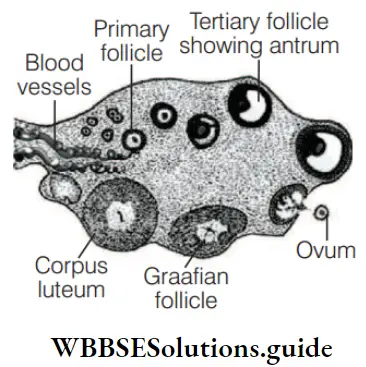
- Primary follicle
- Ovum
- Graafian follicle
- Corpus luteum
Answer: 3. Graafian follicle
Graafian follicle in wrongly labelled as it is a fluid-filled structure formed from tertiary follicle in the mammalian ovary within which secondary oocyte develops prior to ovulation.
Question 42. Identify the labels C and D in the diagram.
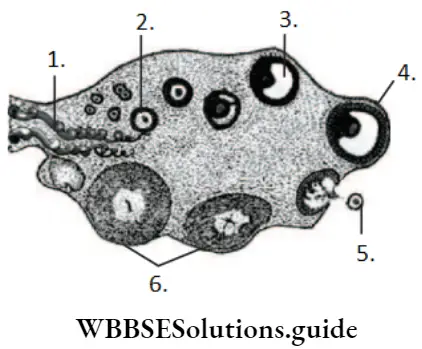
- Secondary spermatocyte and primary spermatocytes
- Tertiary follicles showing antrum and Graafian follicle
- Primary spermatocyte showing antrum and secondary spermatocytes
- Graafian follicle and ovum
Answer: 2. Tertiary follicles showing antrum and Graafian follicle
In the given diagram, C–Tertiary folicle showing antrum, D–Graafian follicle
NEET Biology Mcq
Question 43. Which part of ovary in mammals acts as an endocrine gland after ovulation?
- Graafian follicle
- Stroma
- Germinal epithelium
- Vitelline membrane
Answer: 1. Graafian follicle
After ovulation, the Graafian follicle changes into corpus luteum and secretes progesterone. Hence, Graafian follicle acts as an endocrine gland after ovulation.
Question 44. Graafian follicle contains
- Oogonial cells
- Corpus luteum
- Theca externa and theca interna
- Corpus albicans
Answer: 3. Theca externa and theca interna
Graafian follicle is the mature follicle present in the ovary. It consists of an outermost layer called theca externa and inner to it, theca interna is present.
Question 45. In mammals, oestrogens is secreted by the Graafian follicle from its
- External theca
- Internal theca
- Zona pellucida
- Corona radiate
Answer: 2. Internal theca
In mammals, FSH stimulates the growth and maturation of immature oocytes into mature Graafian follicles before ovulation. Oestrogen is produced by theca interna of the developing follicular cells.
Question 46. Graafian follicles are formed from
- Stroma of ovaries
- Germinal epithelium of ovaries
- Columnar epithelium of testes
- Assembly of ribosomes in blastula
Answer: 2. Germinal epithelium of ovaries
Number of small ovarian follicles are found embedded in the cortical stroma of an ovary. These follicles are initially formed during embryonic development by the proliferation of primordial germ cells of germinal epithelium. Later, they mature into Graafian follicle.
Question 47. Innermost layer of Graafian follicle is
- Membrane granulosa
- Corona radiata
- Theca externa
- Discus proligerus
Answer: 2. Corona radiata
Among given options, corona radiata is the innermost layer of Graafian follicle. It is present directly adjacent to the zona pellucida.
Question 48. In the diagram of section of Graafian follicle, different parts are indicated by alphabets. Choose the answer in which these alphabets have been correctly matched with the parts they indicate.
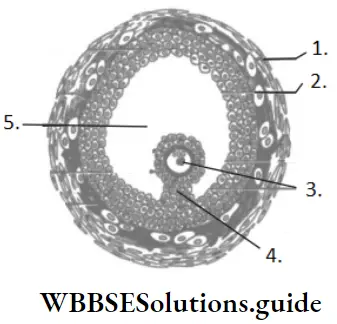
- A–Theca externa, B–Theca interna, C–Ovum, D–Cumulus oophorus, E–Antrum
- A–Membrana granulosa, B–Theca externa, C–Ovum, D–Cumulus oophorus, E–Antrum
- A–Membrana granulosa, B–Theca interna, C–Ovum, D–Cumulus oophorus, E–Anturm
- A–Theca externa, B–Theca interna, C–Ovum, D–Membrana granulosa, E–Antrum
Answer: 1. A–Theca externa, B–Theca interna, C–Ovum, D–Cumulus oophorus, E–Antrum.
Question 49. Consider the following statements.
- Ovulation is the process of follicle rupture and release of ova.
- Ovulatory phase is also known as pre-luteal or post-follicular phase.
Choose the correct option.
- Statement 1 is correct, but 2 is incorrect
- Statement 1 is incorrect, but 2 is correct
- Both statements 1 and 2 are correct
- Both statements 1 and 2 are incorrect
Answer: 3. Both statements 1 and 2 are correct.
Ovulation occur during ovulatory phase due to LH surge. The mature Graafian follicle rupture to release secondary oocyte or ova during this phase. This phase occur before the luteal phase (pre-luteal) and after the completion of follicular phase (postfollicular).
NEET Biology Mcq
Question 50. The shortest phase in menstrual cycle is
- Menstrual phase
- Ovulatory phase
- Secretory phase
- Proliferative phase
Answer: 2. Ovulatory phase
Ovulatory phase occurs on the 14th day of the menstrual cycle and lasts for only one day. Thus, it is the shortest phase of menstrual cycle.
Question 51. Stigma is a spot on the surface of human ovary where
- Oviduct is attached
- Ovulation takes place
- Ovary is attached
- Uterus is attached
Answer: 2. Ovulation takes place
A stigma (also called macula pellucida) in mammalian reproduct4e anatomy refers to the area of the ovarian surface, where the Graafian follicle burst open during ovulation and release the ovum.The stigma later heal and the residual follicle transformes into the corpus luteum.
Question 52. The ovulation occurs
- Alternately from the two ovaries
- Simultaneously from both the ovaries
- From the one ovary alone throughout the life
- From the birth
Answer: 1. Alternately from the two ovaries
Usually, only a single oocyte from one ovary is released during each menstrual cycle, with each ovary taking an alternate turn every month.
Question 53. Ovulation in the human female normally takes place during the menstrual cycle
- At the mid secretory phase
- Just before the end of the secretory phase
- At the beginning of the proliferative phase
- At the end of the proliferative phase
Answer: 4. At the end of the proliferative phase
Ovulation, i.e. the release of secondary oocyte from the Graafian follicle, normally takes place at the end of the proliferative phase.
Question 54. The below diagram describes the changes that occur in the endometrium during a normal menstruation. Choose the option with correct description for points A, B, C and D.
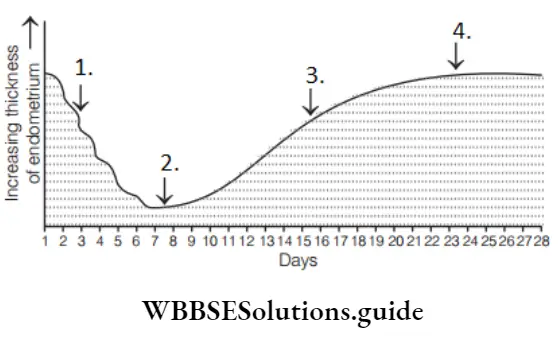
- A–Ovulation, B–Menstruation
- A–Ovulation, C–Menstruation
- A–Menstruation, C–Ovulation
- B–Ovulation, D–Menstruation
Answer: 3. A–Menstruation, C–Ovulation
Ovulation occurs on the 14-16th day of menstrual cycle. This is indicated as C. During menstruation the endometrium wall of the uterus is shed. It takes place at day 1-5 of the menstrual cycle, which is indicated as A.
Question 55. At which phase, LH attain peak level?
- Menstrual phase
- Follicular phase
- Ovulatory phase
- Luteal phase
Answer: 1. Menstrual phase
The peak level of LH is attained during ovulatory phase, when the Graafian follicle is fully matured and burst to release the ovum.
Question 56. Which set is similar?
- Corpus luteum – Graafian follicles
- Sebum – Sweat
- Bundle of His – Pacemaker
- Vitamin-B7 – Niacin
Answer: 1. Corpus luteum – Graafian follicles
The zona granulosa and theca cells of Graafian follicle remain in the ovary after ovulation. They get surrounded by capillaries and the connective tissue evolve in it to form the corpus luteum (a temporary endocrine gland). Thus, Graafian follicle and corpus luteum are similar
Question 57. Probable fertility period of menstrual cycle is from ……… to ………… .
- 5-8 days
- 9-12 days
- 13-16 days
- 17-20 days
Answer: 3. 13-16 days
Ovulation occurs about 14 days before the menstruation starts. If average menstrual cycle is of 28 days, the probable fertility period is from 13 to16 days.
Question 58. If a woman consumes some drug which is rich in LH, then which of the phenomenon occurs ?
- Menstruation stops
- Ovulation will occur
- Activation of oestrogen occurs
- Activation of FSH occurs
Answer: 2. Ovulation will occur
If a women consumes a drug, which is rich in Luteinizing hormone, ovulation will occurs because this hormone causes the rupture of mature Graafian follicle.
Question 59. Which of the following hormone levels will cause release of ovum (ovulation) from the Graafian follicle?
- High concentration of progesterone
- Low concentration of LH
- Low concentration of FSH
- High concentration of oestrogen
Answer: 4. High concentration of oestrogen
Oestrogen level is the highest on 14th day of menstrual cycle. It causes LH rise rapidly during this period and causes release of ovum from Graafian follicle.
NEET Biology Mcq
Question 60. During the ovulatory phase, the structure called corpus luteum is formed from
- Ruptured Graafian follicle
- Epididymis
- Isogametes
- Endometrium
Answer: 1. Ruptured Graafian follicle
Corpus luteum develops from a ruptured Graafian follicle after the release of secondary oocyte from it.
Question 61. Which of the following events is not associated with ovulation in human female?
- Release of secondary oocyte
- LH surge
- Decrease in estradiol
- Full development of Graafian follicle
Answer: 3. Decrease in estradiol
During ovulation, i.e. on day 14th the level of oestrogen or estradiol is the highest in blood. Thus, decrease in estradiol is not associated with ovulation in human female.
Question 62. At the time of ovulation in human female, all are true except that
- First podocyte is expelled
- Zona pellucida is broken down
- Meiosis-I has just occurred
- Meiosis-2 is arrested at metaphase
Answer: 2. Zona pellucida is broken down
All options are correct except the statement in option because the zona pellucida remain intact during ovulation.
Question 63. Identify the incorrect match.
- Ovulation–LH and FSH attain peak and sharp fall in secretion of progesterone
- Secretory phase–Development of corpus luteum and increased secretion of progesterone
- Menstruation–Breakdown of endometrium and ovum is not fertilised
- Proliferative phase–Rapid regeneration of myometrium and maturation of Graafian follicle
Answer: 4. Proliferative phase–Rapid regeneration of myometrium and maturation of Graafian follicle
Option 4 is incorrectly matched and can be corrected as During proliferat4e phase, rapid regeneration of endometrium occurs and Graafian follicle attain maturity at the end of this phase.
Question 64. Assertion Production of FSH increases, while that of LH decreases in the ovulation phase. Reason (R) Due to decrease in the level of LH, ovulation (releasing of ova) takes place.
- Both A and R are true and R is the correct explanation of A
- Both A and R are true, but R is not the correct explanation of A
- A is true, but the R is false
- Both A and R are false
Answer: 4. Both A and R are false
Both A and R are false and can be corrected as During ovulation, production of FSH decreases, while that of LH increases. Increase in the level of LH results in ovulation.
NEET Biology Menstrual Cycle MCQs with explanations
Question 65. Consider the following statements.
- LH surge refers to rapid secretion of LH.
- LH surge occurs during the middle of menstrual cycle.
Choose the correct option.
- Statement 1 is correct, but 2 is incorrect
- Statement 1 is incorrect, but 2 is correct
- Both statements 1 and 2 are correct
- Both statements 1 and 2 are incorrect
Answer: 3. Both statements 1 and 2 are correct.
LH surge is rapid secretion of LH leading to its maximum level, during the middle of menstrual cycle. It results in ovulation.
Question 66. An oocyte is released from the ovary under the influence of LH
- After completing meiosis and before polar bodies are released
- After completing meiosis-1 and before the release of polar bodies
- After completing meiosis
- After completing meiosis-1 and after the release of polar bodies
Answer: 4. After completing meiosis-1 and after the release of polar bodies
In human females, ova are released from the ovary in the secondary oocyte stage. It has completed first meiotic d4ision and released the first polar body.
Question 67. Longest period of menstrual cycle is
- Secretory phase
- Ovulatory phase
- Menstrual phase
- Pre-ovulatory phase
Answer: 1. Secretory phase
Longest period of menstrual cycle is secretory or luteal phase which extends from 15th to 28th day of the menstrual cycle. It occur after ovulation.
Question 68. Secretory phase is also known as
- Luteal phase
- Destructive phase
- Follicular phase
- Ovulatory phase
Answer: 1. Luteal phase
The secretory phase is also known as the luteal phase due to the occurrence of corpus luteum during this phase.
Question 69. The secretory phase of the menstrual cycle lasts for about
- 14 days
- 8 days
- 6 days
- 3 days
Answer: 1. 14 days
Secretory phase of the menstrual cycle extends from 15th to 28th day of the menstrual cycle. Thus, it lasts for about 14 days.
Question 70. The phase of menstrual cycle where fertilisation may occur is
- Follicular
- Luteal
- Bleeding phase
- None of these
Answer: 2. Luteal
The chances of fertilisation or conception are higher after the release of ova, that is during the luteal phase.
NEET Biology Mcq
Question 71. After ovulation, the collapsed ovarian follicle shrinks and becomes filled with cells to form
- Corpus atresia
- Corpus adiposum
- Corpus luteum
- Corpus albicans
Answer: 3. Corpus luteum
After the release of secondary oocyte during ovulation, remaining components of Graafian follicle transform into corpus luteum.
Question 72. Which of the following is correct about secretory phase of human menstrual cycle?
- It is also called follicular phase and includes cycle days 6-13
- It is also called proliferat4e phase and includes cycle days 13-26
- It is also called luteal phase and includes cycle days 15-28
- It is also called menstrual phase and includes cycle days 3-5
Answer: 3. It is also called luteal phase and includes cycle days 15-28
Option 3 is correct as Secretory phase is also called as luteal phase. It includes days 15-28 in a 28 days cycle.
Question 73. Which is not true about the luteal phase of the menstrual cycle?
- Progesterone level is high
- Fertilisation may occur
- Ovulation occurs
- The endometrial glands enlarge
Answer: 3. Ovulation occurs
In luteal phase of menstrual cycle, ovulation does not occur. Infact this phase occur immediate after ovulation.
Question 74. Study the graph and correlate the uterine events to the hormonal levels on
- 6-15 days
- 16-25 days
- 26-28 days (if the ovum is not fertilised)
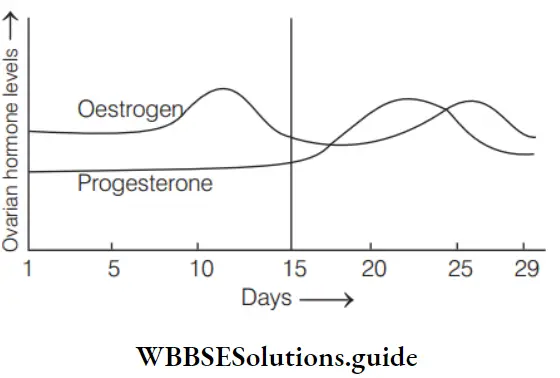
Choose the correct option that describes the events and the hormonal levels.
- A–Regeneration of corpus luteum, B–Myometrium thickens, becomes vascularised ready for implantation of embryo, C–Degeneration of endometrium
- A–Degeneration of endometrium, B–Graafian follicle thickens, becomes vascularised, ready to receive and implant ovum, C–Regeneration of endometrium
- A–Degeneration of endometrium, B–Endometrium thickens, becomes vascularised, ready for implantation of embryo, C–Regeneration of endometrium
- A–Regeneration of endometrium, B–Endometrium thickens, becomes vascularised ready to receive and implant embryo, C–Degeneration of endometrium.
Answer: 4. A–Regeneration of endometrium, B–Endometrium thickens, becomes vascularised ready to receive and implant embryo, C–Degeneration of endometrium.
NEET Biology Mcq Chapter Wise
Question 75. The substance secreted by the corpus luteum is
- Hormone
- Enzyme
- Pheromone
- Bile
Answer: 1. Hormone
Hormone is secreted by corpus luteum.
Question 76. Main function of corpus luteum is
- Facilitate fertilisation
- Facilitate ovulation
- Secrete progesterone
- Facilitate passage of ova in oviduct
Answer: 3. Secrete progesterone
Progesterone is secreted by the corpus luteum which help to sustain endometrium for implantation of zygote, if fertilisation occurs.
Question 77. Which hormone level reaches peak during luteal phase of menstrual cycle ?
- Luteinizing hormone
- Progesterone
- Follicle stimulating hormone
- Oestrogen
Answer: 2. Progesterone
During the luteal phase, the corpus luteum secretes increasing quantities of progesterone due to which it attains the peak during this phase.
Question 78. Secretion from which of the following structures prepares the inner wall of the uterus for implantation?
- Ovary
- Pituitary gland
- Corpus luteum
- Ovarian follicle
Answer: 3. Corpus luteum
Secretion from corpus luteum prepares the inner wall (endometrium) of the uterus for implantation.
Question 79. The corpus luteum secretes progesterone that conveys negat4e feedback and inhibits the release of
- ABP and ICSH
- LH and ICSH
- LH and FSH
- FSH and TSH
Answer: 3. LH and FSH
The corpus luteum secretes progesterone, which exerts negat4e feedback and inhibits the release of gonadotropins, LH and FSH during luteal phase.
Question 80. Assertion Luteal phase of menstrual cycle is also called as secretory phase. Reason (R) Corpus luteum is formed in this phase which secretes progesterone.
- Both A and the R are true and R is the correct explanation of A
- Both A and R are true, but R is not the correct explanation of A
- A is true, but R is false
- Both A and R are false
Answer: 1. Both A and R are true and R is correct explanation of A.
During the luteal phase, corpus luteum is formed in the ovary. It secretes progesterone due to which this phase is also called secretory phase.
Menstrual Cycle mock test for NEET preparation
Question 81. Which one of the following is the correctly matched event occurring during the menstrual cycle?
- Ovulation–LH and FSH attains the peak level and a sharp fall in the secretion of progesterone
- Proliferat4e phase–Rapid regeneration of myometrium and maturation of Graafian follicle
- Development of corpus luteum– Secretory phase and increased secretion of progesterone
- Menstruation–Breakdown of myometrium and ovum do not fertilised
Answer: 3. Development of corpus luteum– Secretory phase and increased secretion of progesterone
- Option is correctly matched. In secretory phase, a yellowish structure called corpus luteum is formed. The corpus luteum plays an important role in the preparation of endometrium for the implantation of the fertilised egg by secreting oestrogen and progesterone.
- Other options are incorrectly matched and can be corrected as During ovulation, LH attains peak level and not FSH. During proliferative phase, endometrium proliferates and during mensuration, breakdown of endometrium occurs.
Question 82. Match the hormones in Column I with their functions in Column 2.
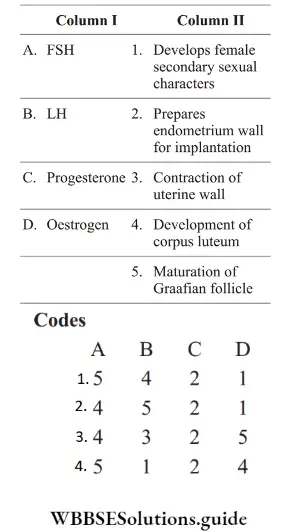
Answer: 1. A–5, B–4, C–2, D–1
Question 83. Before the formation of corpus luteum, the body formed is
- Corpous albicans
- Corpous media
- Corpous haemorrhagicum
- None of the above
Answer: 3. Corpous haemorrhagicum
The corpus hemorrhagicum (bleeding corpus luteum ) is a temporary structure formed immediately after ovulation before the formation of corpus luteum. It is formed from the ovarian follicle as it collapses and is filled with blood that quickly clots.
Question 84. Consider the following statements.
- Oestrogen level rise during mid-follicular and mid-luteal phase.
- Oestrogen level fall immediate after ovulation.
Choose the correct option.
- Statement 1 is correct, but 2 is incorrect
- Statement 1 is incorrect, but 2 is correct
- Both statements 1 and 2 are correct
- Both statements 1 and 2 are incorrect
Answer: 3. Both statements 1 and 2 are correct.
NEET Biology Mcq Chapter Wise
Question 85. The following graph of relat4e concentrations of the four hormones present in the blood plasma of a woman during her menstrual cycle. Identify the hormones A, B, C and D.
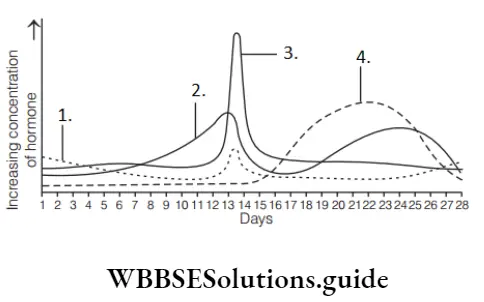
- A–FSH, B–Progesterone, C–LH, D–Oestrogen
- A–LH, B–Progesterone, C–FSH, D–Oestrogen
- A–FSH, B–Oestrogen, C–LH, D–Progesterone
- A–LH, B–Oestrogen, C–FSH, D–Progesterone
Answer: 3. A–FSH, B–Oestrogen, C–LH, D–Progesterone.
Question 86. No new follicles develop in the luteal phase of the menstrual cycle because
- Follicles do not remain in the ovary after ovulation
- FSH levels are high in the luteal phase
- LH levels are high in the luteal phase
- Both FSH and LH levels are low in the luteal phase
Answer: 4. Both FSH and LH levels are low in the luteal phase
Due to the low level of LH and FSH, no new follicle develops or grow during the luteal phase of menstrual.
Question 87. The figure shows a section of human ovary. Select the option which g4es the correct identification ofA and B with function/characteristic
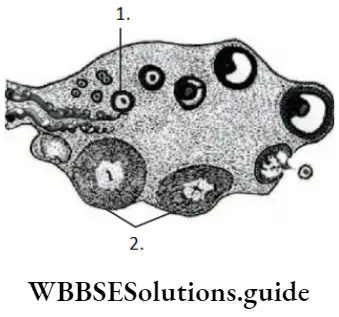
- A–Primary oocyte–It is the prophase-I of the meiotic d4ision
- B–Corpus luteum–Secretes progesterone
- A–Tertiary follicle–Forms Graafian follicle
- B–Corpus luteum–Secretes oestrogen
Answer: 2. B–Corpus luteum–Secretes progesterone
In the g4en diagram, B is corpus luteum which secrete progesterone during luteal phase of menstrual cycle.
Question 88. The events of the menstrual cycle are represented below. In which of the following option, the level of FSH, LH and progesterone is mentioned correctly.
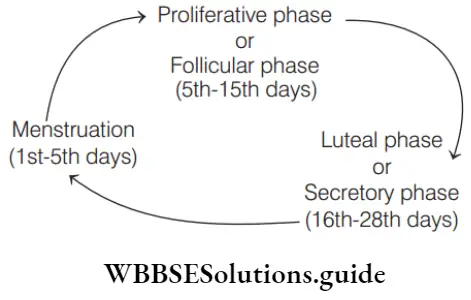
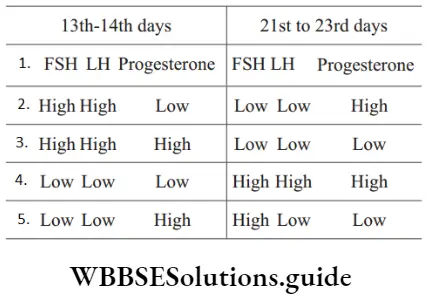
Answer: 1. Option 1 correctly mention the level of different hormones at g4en periods. During the 13th-14th days, Graafian follicle reaches the vertex of maturity and ovulation occurs.
Thus, FSH and LH are at high level, whereas progesterone level is low. During 21st-23rd days, i.e. the middle of luteal phase, progesterone level is high, whereas the level of gonadotropins, LH and FSH is low so as to suppress the growth of new follicles.
NEET Biology Mcq Chapter Wise
Question 89. When pregnancy does not occur, the life of corpus luteum is about
- 10 days
- 14 days
- 28 days
- Corpus luteum is not found
Answer: 2. 14 days
The lifespan of corpus luteum is about 14 days in the absence of fertlisation. It is similar to that of luteal phase.
Question 90. If after ovulation no pregnancy results, the corpus luteum
- Is maintained by the presence of progesterone
- Degenerates in a short time
- Becomes act4e and secretes lot of FSH and LH
- Produces lot of oxytocin and relaxin
Answer: 2. Degenerates in a short time
In the absence of pregnancy, the egg is not fertilised. The corpus luteum stops secreting progesterone and degenerates in short time.
Question 91. If fertilisation of egg does not occur the corpus luteum
- Reduces secretion of progesterone
- Changes to corpus albicans
- Enhances secretion of progesterone
- level of progesterone and oestrogen increases
Answer: 2. Changes to corpus albicans
If the ovum is not fertilised, the corpus luteum changes to white or colourless structure called corpus albicans.
Question 92. Corpus luteum is maintained in a woman under the effect of
- Prolactin
- Oestrogen
- Human chorionic gonadotropin
- Somatomammotropin
Answer: 3. Human chorionic gonadotropin
Corpus luteum secretes significant amounts of progesterone hormone and moderate amounts of hormones like estradiol and relaxin. human Chorionic Gonadotropin (hCG) hormone maintains corpus luteum to secrete progesterone during pregnancy.
Question 93. Both corpus luteum and macula lutea are
- Found in human ovaries
- A source of hormones
- Characterised by a yellow colour
- Contributory in maintaining pregnancy
Answer: 3. Characterised by a yellow colour
Both corpus luteum and macula lutea are characterised by yellow colour. After an egg is released from the ovary, the cells that line the ovarian follicle change shape and colour to become a corpus luteum (yellow body). Macula lutea is the yellowish spot present at the posterior pole of eye.
94. In females, the hormone inhibin is secreted by
- Granulosa and theca cells
- Granulosa cells and corpus luteum
- Granulosa and cumulus oophorus cells
- Granulosa cells and zona pellucida
Answer: 2. Granulosa cells and corpus luteum
Inhibin is produced in females by granulosa cell and corpus luteum under the control of FSH and Luteinizing Hormone (LH).
NEET practice test on Menstrual Cycle
Question 95. If mammalian ovum fails to get fertilised, which one of the following is unlikely?
- Corpus luteum will disintegrate
- Progesterone secretion rapidly declines
- Oestrogen secretion further decreases
- Primary follicle starts developing
Answer: 3. Oestrogen secretion further decreases
If the mammalian ovum fails to get fertilised, corpus luteum degenerates, so progesterone also decreases rapidly. Primary follicle start developing and estrogen secretion does not decrease further.
Thus, option 3 is incorrect.
Question 96. When uterine bleeding stops in females at age of 50 years the stage is called
- Menopause
- Menstrual
- Monarche
- Mesovarium
Answer: 1. Menopause
Menopause is defined as the phase when menstrual cycle permanently cease due to the natural depletion of ovarian oocytes from ageing. It marks the permanent end of fertility.
NEET Biology Mcq Chapter Wise
Question 97. In woman, cessation of menstruation occurs at the age of
- 12-14 years
- 45-58 years
- 60 years
- Does not occur at all
Answer: 2. 12-14 years
Cessation of menstrual cycle is called menopause. It occurs in females at the age of 45-58 years.
Question 98. Match the following columns.
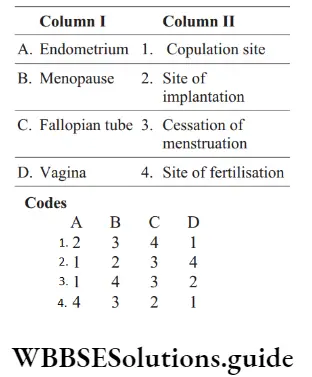
Answer: 1. A-2, B-3, C-4, D-1
Question 99. At menopause, there is rise in urinary excretion of
- FSH
- STH
- Progesterone
- MSH
Answer: 1. FSH
- During menopause, when oestrogen production falls below a critical value, it can no longer inhibit the production of the gonadotropins FSH and LH.
- Instead, the gonadotropins FSH and LH (mainly FSH) are produced after menopause in large and continuous quantities. Thus, these (mainly FSH) are excreted out in the urine.
